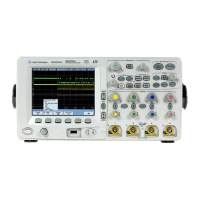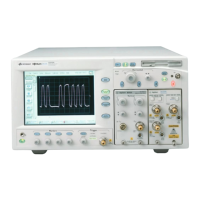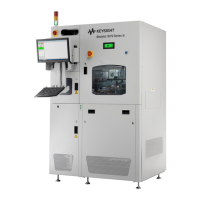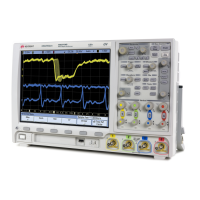:WAVeform Commands 32
Agilent InfiniiVision 3000 X-Series Oscilloscopes Programmer's Guide 965
Use the :WAVeform:UNSigned command (see page 987) to control whether
data values are sent as unsigned or signed integers. This command can be
used to match the instrument's internal data type to the data type used by
the programming language. This command has no effect if the data format
is ASCii.
Data Format for Transfer - ASCii format
The ASCii format (see ":WAVeform:FORMat" on page 971) provides
access to the waveform data as real Y-axis values without using Y
origin, Y reference, and Y increment to convert the binary data. Values
are transferred as ASCii digits in floating point format separated by
commas. In ASCii format, holes are represented by the value 9.9e+37.
The setting of :WAVeform:BYTeorder (see page 967) and
:WAVeform:UNSigned (see page 987) have no effect when the format is
ASCii.
Data Format for Transfer - WORD format
WORD format (see ":WAVeform:FORMat" on page 971) provides 16- bit
access to the waveform data. In the WORD format, the number of data
bytes is twice the number of data points. The number of data points is
the value returned by the :WAVeform:POINts? query (see page 972). If
the data intrinsically has less than 16 bits of resolution, the data is
left-shifted to provide 16 bits of resolution and the least significant bits
are set to 0. Currently, the greatest intrinsic resolution of any data is
12 bits, so at least the lowest 4 bits of data will be 0. If there is a hole
in the data, the hole is represented by a 16 bit value equal to 0.
Use :WAVeform:BYTeorder (see page 967) to determine if the least
significant byte or most significant byte is to be transferred first. The
:BYTeorder command can be used to alter the transmit sequence to
match the storage sequence of an integer in the programming language
being used.
Data Format for Transfer - BYTE format
The BYTE format (see ":WAVeform:FORMat" on page 971 ) allows 8-bit
access to the waveform data. If the data intrinsically has more than 8
bits of resolution (averaged data), the data is right- shifted (truncated)
to fit into 8 bits. If there is a hole in the data, the hole is represented
by a value of 0. The BYTE- formatted data transfers over the
programming interface faster than ASCii or WORD- formatted data,
because in ASCii format, as many as 13 bytes per point are transferred,
in BYTE format one byte per point is transferred, and in WORD format
two bytes per point are transferred.
The :WAVeform:BYTeorder command (see page 967) has no effect when
the data format is BYTE.
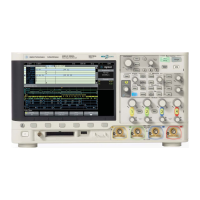
